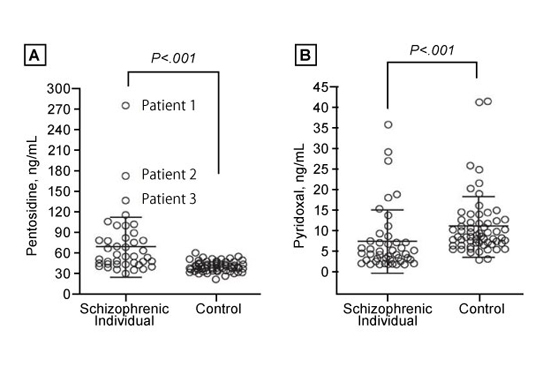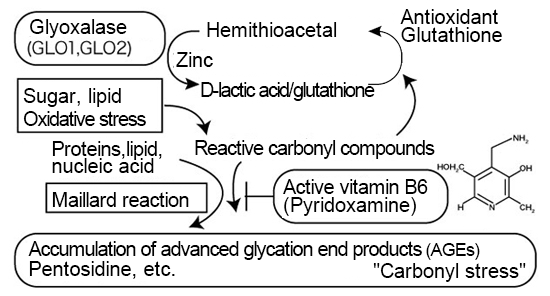Glycative stress and Anti-aging
Glycative stress and schizophrenia
Glycative stress and schizophrenia
What is schizophrenia?
Schizophrenia is a mental disease that 1 in 100 people suffer, and is in the same category as the following mood disorders: major depression and bipolar disorder. Schizophrenia is characterized by symptoms including hallucination and delusion. With this disease, the patients suffer from an inability to live with their family or in society while interacting with other people. It is difficult for them to think back on “their distorted feeling(s), thought(s) and behavior due to the disease”. The advance of the disease tends to be associated with a chronic course. During that time, there is an acute stage where patients strongly suffer from hallucinations and delusions. According to the patient survey in 2014 (conducted by the Ministry of Health, Labour and Welfare), among the 266,000 inpatients with mental diseases, 166,000 of the patients had schizophrenia, a schizophrenia-related disorder, or a delusional disorder. This number is not small by any means1). Schizophrenia is not widely recognized because the symptoms are not obvious, there are social prejudices against it and the only treatment available is symptomatic pharmacotherapy.
Schizophrenia and AGEs
Regarding schizophrenia, many relationships with chromosome VI have been reported2). The chromosome contains an enzyme gene called glyoxalase 1 (GLO1). Glyoxalase decomposes carbonyl compounds, a glycation reaction intermediate that is produced via oxidative stress or glycative stress. It’s revealed that schizophrenic patients with carbonyl stress had a frameshift mutation in the GLO1 gene and that the expression of GLO1 decreases by up to 50% compared to that of healthy people, according to the DNA analysis concerning the proband of the multiplex family with schizophrenia 2). With the patients in this case, it was also found that the concentration of pentosidine, a type of AGEs in the blood, increased 3.7 times compared to healthy subjects, and vitamin B6, which acts as a carbonyl scavenger in vivo just like glyoxalase, decreased to 20%. In addition, the survey of schizophrenic patients without diabetes, renal disorders and inflammatory diseases showed that the concentration of pentosidine in the blood significantly increased and that the concentration of vitamin B6 significantly decreased (Fig. 1)3).

Fig. 1 Amount of pentosidine in plasma and
pyridoxal in serum (vitamin B6)
A: pentosidine, B: pyridoxal (vitamin B6)
Arai M, et al (2010)3)
Potential treatment for schizophrenia by inhibiting glycative stress
With schizophrenic patients with carbonyl stress, vitamin B6 in the blood decreases. Therefore, supplemental treatment with vitamin B6 may be effective. Vitamin B6 contains 3 substances (pyridoxine, pyridoxal and pyridoxiamine) that have a reciprocal chemical equilibrium in the solution (Fig. 2).

Fig. 2 Structural formula of vitamin B6
Among these substances, pyridoxamine acts as a carbonyl scavenger4). Accordingly, pyridoxamine may be able to improve schizophrenia by inhibiting carbonyl stress via glycation and oxidation of a living body (Fig. 3)5). Currently, clinical trials that administer pyridoxamine to schizophrenic patients are conducted and the data is being analyzed 6).

Fig. 3 Amount of pentosidine in plasma and pyridoxal in serum (vitamin B6)
A: Pentosidine, B: Pyridoxal (vitamin B6)
References
-
- 厚生労働省, 平成26年患者調査
- Turecki G, et al. : Am J Med Genet. 1997 ; 74 :195–198.
- Arai M, et al. : Arch Gen Psychiatry. 2010 ; 67 : 589-597.
- Voziyan PA, et al. : J Biol Chem. 2002 ; 277 : 3397-3403.
- 新井誠ら:精神経誌. 2012 ; 114 : 199-208.
- 糸川昌成ら:日本抗加齢医学会誌. 2012 ; 8 : 49-54.
Glycative stress and Anti-aging
- What is glycative stress?
- Glycative stress biomarker measurement method (1) Measurement of blood glucose, glycated protein and glycation reaction intermediate
- Glycative stress biomarker measurement method (2)AGEs measurement
- Glycative stress biomarker measurement method (3) Evaluation of anti-glycative effects
- Glycative Stress and AGEs Receptors
- What is kidney disease?
- Glycative Stress and Skin Aging
- Glycative stress and arteriosclerotic disease
- Glycative stress and schizophrenia
- Glycative stress and liver disease
- Glycative stress and infertility
- Glycative stress and Alzheimer’s disease
- Glycative stress countermeasures (1) Blood glucose control
- Glycative stress countermeasures (2) Inhibition of glycation reaction
- Measures against glycative stress (3) Degradation and excretion of AGEs
- Measures against glycative stress (4) AGEs contained in food
- Issues and prospects of glycative stress countermeasures